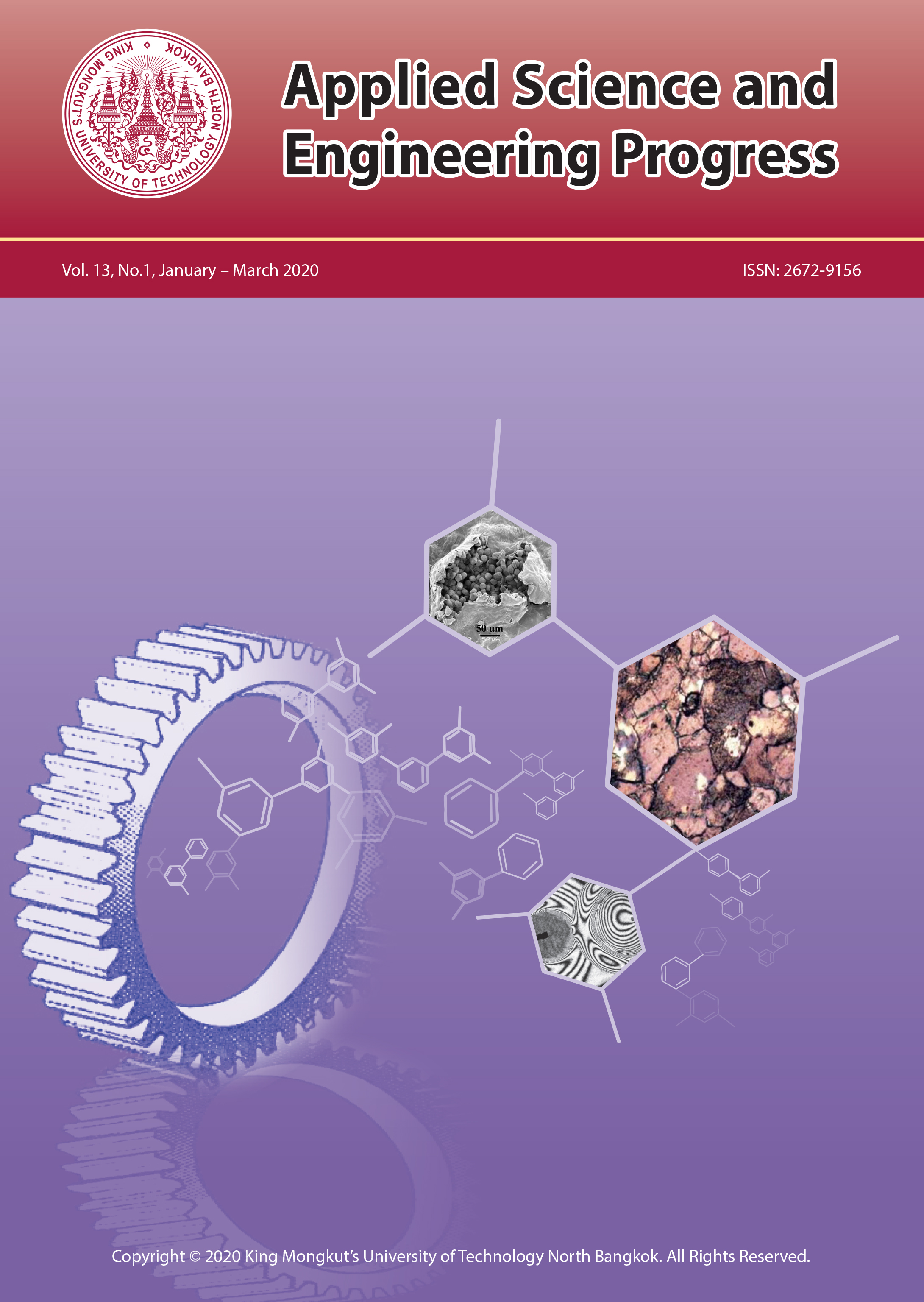Reduction of Scrap in Anodization Process: A Case Study in a Cosmetic Packaging Industry
Main Article Content
Abstract
According to the production process conditions in the company case study, in particular the operation of anodization department for coating of the packaging, the defects of the process have been found significantly. Referring to the primary analysis, the defects are caused from inappropriate chemical parameters in anodization process and also inappropriate packaging wash after the anodizing process when the highest amount of paint losses is found in scrap. The scrap value of both matte coating process and glossy coating process is about USD 2,800 per month. The objectives of this research are to study aluminium alloy metal coating process with sulfuric acid under particular conditions and to determine appropriate conditions for material surface coating. The appropriate level of the turbidity is 12.4242 NTU and the concentration is 220 g/L for matte coating process. Glossy coating process can be reduced to the appropriate level of the turbidity at 3.4040 NTU and the concentration is 303.33 g/L. In addition, this can reduce defect on the paint loss packaging from anodizing process, and coating process condition in matte coating process up to 67.77% and glossy coating process is also reduced by 66.02%.
Article Details
References
[2] W. Thaweesuk, “The study of factors effecting the crown inducement of write/read head assembly of hard disk drive by using the design of experiment,” M.S. thesis, Faculty of Engineering, Chulalongkorn University, Bangkok, Thailand, 2003 (in Thai).
[3] W. Pookpasuk, “Defect Reduction in chromium plating process by applying six sigma solution case study: A company in chromium plating industry,” M.S. thesis, Faculty of Engineering, King Mongkut’s University of Technology North Bangkok, Bangkok, Thailand, 2008 (in Thai).
[4] C. Chotyakun, “Paper coating cost reduction with specified conditions,” M.S. thesis, Faculty of Engineering, King Mongkut’s University of Technology North Bangkok, Bangkok, Thailand, 2002 (in Thai).
[5] C. Maicharoen, “The productivity improvement in a rice bran refining process with the experimental design case study: A refinery of rice bran,” M.S. thesis, Faculty of Engineering, King Mongkut’s University of Technology North Bangkok, Bangkok, Thailand, 2003 (in Thai).
[6] P. Boonraksa, “A study of optimal factor in tinplate process using design of experiment,” M.S. thesis, Faculty of Engineering, King Mongkut’s University of Technology North Bangkok, Bangkok, Thailand, 2014 (in Thai).
[7] S. Pimsan, “Determining an Optimal Parameter for polyester powder coating on can’s lap weld seam,” M.S. thesis, Faculty of Engineering, King Mongkut’s University of Technology North Bangkok, Bangkok, Thailand, 2004 (in Thai).
[8] S. Arakworakul, “A study of optimal conditions in anodize piston valve process using design and analysis of experiment,” M.S. thesis, Faculty of Engineering, King Mongkut’s University of Technology North Bangkok, Bangkok, Thailand, 2010 (in Thai).
[9] S. Tuammee, “Defect reduction in plastic sheet process by applying the design of experiments a company case study in plastic industry,” M.S. thesis, Faculty of Engineering, King Mongkut’s University of Technology North Bangkok, Bangkok, Thailand, 2007 (in Thai).
[10] P. G. Miney, P. E. Colavita, M. V. Schiza, R. J. Priore, F. G. Haibach, and M. L. Myrick, “Growth and characterization of a porous aluminum oxide film formed on an electrically insulating support,” Electrochem and Solid-State Letters, vol. 6, no. 10, pp. B42–B45, 2003.
[11] N. Saleema, D. K. Sarkar, R.W. Paynter, D. Gallant, and M. Eskandarian, “A simple surface treatment and characterization of AA 6061 aluminum alloy surface for adhesive bonding applications,” Applied Surface Science, vol. 261, pp. 742–748, 2012.
[12] M. Shahzad, M. Chaussumier, R. Chieragatti, C. Mabru, and F. Rezai-Aria, “Surface characterization and influence of anodizing process on fatigue life of Al 7050 alloy,” Material and Design, vol. 32, no. 6, pp. 3328–3335, 2011.
[13] R. Jethra, “Turbidity measurement,” ISA Transactions, vol. 1993, no. 32, pp. 397–405, 1993.
[14] Hanna Instruments. (2016,Oct.). Turbidity Portable Meter HI98703-01. Hanna Instruments Company. Rhode Island, USA [Online]. Available: http:// hannainst.com/hi98703-turbidity-portable-meter. html
[15] S. Altuntas and F. Buyukserin, “Fabrication and characterization of conductive anodic aluminum oxide substrates,” Applied Surface Science, vol. 318, pp. 290–296, Nov. 2014.
[16] P. Chutima, Engineering Design of Experiment. Bangkok, Thailand: Chulalongkorn University Press, 2002 (in Thai).
[17] D. C. Montgomery, Design and Analysis of Experiments, 6th ed., New Jersey: John Wiley & Sons, Inc., 2005.
[18] K. Kanchanasuntorn, Quality Control of Statistical. Bangkok, Thailand: Chulalongkorn University Press, 2016 (in Thai).
[19] S. Talabkaew, System Reliability and Maintenance. Bangkok, Thailand: King Mongkut’s University of Technology North Bangkok Press, 2007 (in Thai).
[20] P. Sudasna-na-Ayudthya and P. Luangpaiboon, Design and Analysis of Experiments. Bangkok, Thailand: Top Publishing Co. Ltd., 2008 (in Thai).


